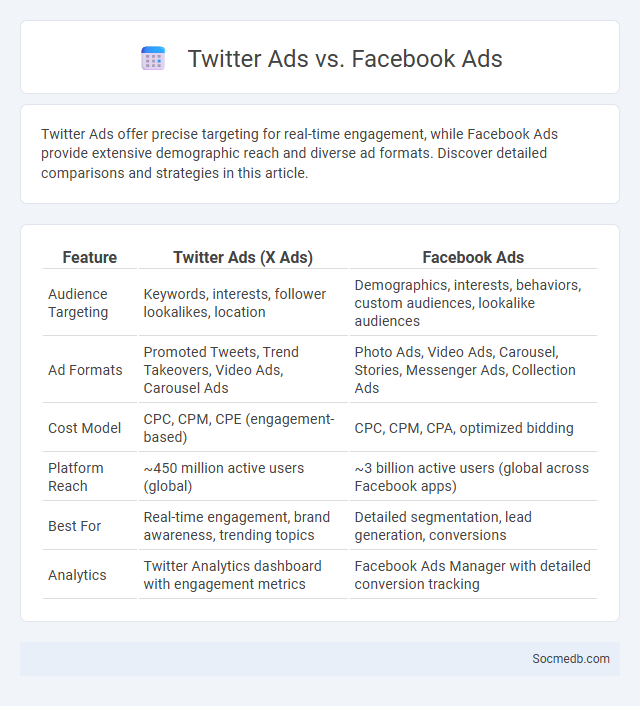
Photo illustration: Twitter Ads vs Facebook Ads
Twitter Ads offer precise targeting for real-time engagement, while Facebook Ads provide extensive demographic reach and diverse ad formats. Discover detailed comparisons and strategies in this article.
Table of Comparison
| Feature | Twitter Ads (X Ads) | Facebook Ads |
|---|---|---|
| Audience Targeting | Keywords, interests, follower lookalikes, location | Demographics, interests, behaviors, custom audiences, lookalike audiences |
| Ad Formats | Promoted Tweets, Trend Takeovers, Video Ads, Carousel Ads | Photo Ads, Video Ads, Carousel, Stories, Messenger Ads, Collection Ads |
| Cost Model | CPC, CPM, CPE (engagement-based) | CPC, CPM, CPA, optimized bidding |
| Platform Reach | ~450 million active users (global) | ~3 billion active users (global across Facebook apps) |
| Best For | Real-time engagement, brand awareness, trending topics | Detailed segmentation, lead generation, conversions |
| Analytics | Twitter Analytics dashboard with engagement metrics | Facebook Ads Manager with detailed conversion tracking |
Introduction to Twitter Ads vs Facebook Ads vs Trending Topics
Twitter Ads offer precise targeting based on real-time conversations and trending topics, allowing your brand to engage with a dynamic audience interested in current events. Facebook Ads provide robust demographic and interest-based targeting, leveraging extensive user data to deliver personalized campaigns across diverse content formats. Understanding the strengths of both platforms helps you optimize your social media strategy by aligning ad objectives with user behavior and trending content relevance.
Audience Targeting: Twitter Ads vs Facebook Ads
Twitter Ads leverage real-time conversation data and follower interests for precise audience targeting, optimizing engagement within trending topics and live events. Facebook Ads utilize extensive demographic, behavioral, and interest-based data from over 2.9 billion monthly users, enabling highly granular custom audience segments and lookalike modeling. Businesses benefit from Twitter's contextual targeting for topical campaigns, while Facebook's comprehensive user data supports broader and more detailed audience personalization.
Cost Comparison: Twitter Ads vs Facebook Ads
Twitter Ads and Facebook Ads differ significantly in cost efficiency based on audience targeting and campaign goals. Facebook Ads generally offer lower average cost-per-click (CPC) ranging from $0.50 to $2.00, while Twitter Ads CPC can be higher, often between $0.50 to $4.00, depending on competition. Budget flexibility and bidding strategies on both platforms influence overall ad spend, with Facebook providing more diverse ad formats and advanced targeting options driving better return on investment (ROI) for many advertisers.
Ad Formats: Twitter and Facebook Differences
Twitter offers unique ad formats such as Promoted Tweets, which blend seamlessly into users' feeds, and Twitter Cards that enhance media engagement through rich visuals. Facebook provides a wider array of ad formats including Carousel Ads, Video Ads, and Collection Ads, designed to create immersive experiences and drive higher conversions. Understanding your brand's goals helps in selecting the optimal platform, as Twitter excels in real-time engagement while Facebook delivers comprehensive targeting and diverse ad placements.
Engagement Metrics: Analyzing Twitter, Facebook, and Trending Topics
Tracking engagement metrics on Twitter and Facebook reveals valuable insights into audience behavior and content effectiveness, highlighting likes, shares, comments, and retweets as key indicators. Trending topics drive organic reach and interaction, allowing Your brand to capitalize on real-time conversations and increase visibility through relevant hashtags and timely posts. Analyzing these metrics empowers strategic content adjustments to maximize social media impact and foster stronger community connections.
Leveraging Trending Topics for Ad Campaigns
Leveraging trending topics in your social media ad campaigns boosts engagement by aligning content with current conversations and viral moments. Utilizing real-time data analytics helps identify which trends resonate most with your target audience, optimizing ad relevance and reach. Your brand gains increased visibility and credibility by tapping into popular hashtags and cultural moments.
Platform Algorithm: How Content Reaches Audiences
Platform algorithms use machine learning to analyze user behavior, including likes, shares, comments, and watch time, to prioritize content that matches individual preferences. These algorithms rank posts based on relevance, engagement potential, and recency, enabling personalized feeds that maximize user retention. Understanding algorithm mechanics is crucial for content creators aiming to increase visibility and audience reach on platforms like Instagram, TikTok, and Facebook.
Brand Awareness Strategies with Twitter, Facebook, and Trends
Leveraging Twitter's real-time engagement helps you amplify brand visibility by participating in trending conversations and using targeted hashtags to reach relevant audiences. Facebook's robust advertising platform allows precise demographic targeting, enhancing brand awareness through personalized content and interactive posts. Monitoring current social media trends enables your brand to stay relevant and adapt strategies that resonate with evolving consumer interests and behaviors.
Case Studies: Success Stories on Each Platform
Examining case studies reveals how brands like Nike excelled on Instagram by leveraging influencer partnerships and visually striking content to boost engagement and sales. On TikTok, companies such as Chipotle harnessed viral challenges and authentic user stories to rapidly increase follower growth and brand loyalty. You can apply these proven strategies to tailor your campaigns effectively across platforms, maximizing reach and impact.
Choosing the Right Platform for Your Marketing Goals
Selecting the appropriate social media platform relies heavily on understanding your target audience's demographics and behavior patterns to maximize engagement and conversion rates. Platforms like Instagram and TikTok are ideal for brands aiming to reach younger audiences with visually-driven content, whereas LinkedIn suits B2B marketing focused on professional networking and lead generation. Leveraging platform-specific analytics tools enables marketers to refine strategies, ensuring alignment with business objectives and optimal return on investment.
 socmedb.com
socmedb.com